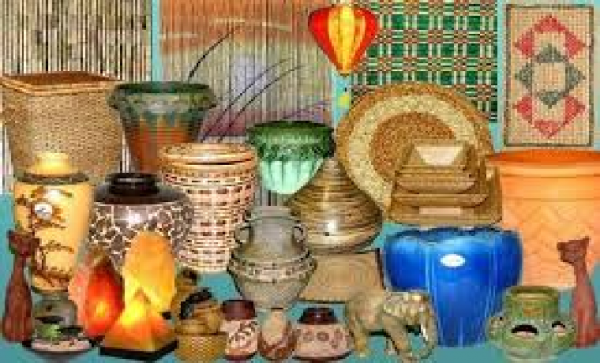INDIAN HANDICRAFTS INDUSTRY

India is one of the important suppliers of handicrafts to the world market. The Indian handicrafts industry is highly labour intensive cottage based industry and decentralized, being spread all over the country in rural and urban areas. Numerous artisans are engaged in crafts work on part-time basis. The industry provides employment to over six million artisans (including those in carpet trade), which include a large number of women and people belonging to the weaker sections of the society.
In addition to the high potential for employment, the sector is economically important from the point of low capital investment, high ratio of value addition, and high potential for export and foreign exchange earnings for the country. The export earnings from Indian handicrafts industry for the period 1998-99 amounted to US$ 1.2 billion.
Although exports of handicrafts appear to be sizeable, India’s share in world imports is miniscule. It is a sector that is still not completely explored from the point of view of hidden potential areas. India, a country with 26 states and 18 languages and more than 1500 dialects offers an enormous range of handicrafts from each of the states. Major centres in Uttar Pradesh are Moradabad also known as the "Peetalnagari" (City of Brass), Saharanpur for its wooden articles, Ferozabad for Glass. The North Western state of Rajasthan has to offer the famous Jaipuri quilts, Bagru and Sanganer printed textiles and wooden and wrought iron furniture from Jodhpur. The coastal state of Gujarat comes with embroidered articles from Kutch. Narsapur in Andhra Pradesh is famous for its Lace and Lace goods. But this is only a small part of the total product range. India offers much more.
Handicrafts are classified into two categories:
Articles of everyday use
Decorative items
The craftsmen use different media to express their originality. The diversity of the handicrafts is expressed on textiles, metals – precious and semi-precious, wood, precious and semi-precious stones, ceramic and glass.
Textile based handicrafts:
Hand printed textiles including block and screen printing, batik, kalamkari (hand printing by pen) and bandhani (tie and die) are used in products ranging from bed-covers to sheets, dress material to upholstery and tapestry. The famous embroidered articles of silk and cotton, often embellished with mirrors, shells, beads, and metallic pieces are also found in India. Embroidery is done too on leather, felt and velvet etc. This segment of the industry accounts for almost half a million strong employment in addition to a large number of designers, block makers, weavers and packers involved in the trade.
Clay, Metal and Jewellery:
Brass, copper, bronze, bell metal are used for a variety of wares and in a variety of finishes. Scintillating ornaments are available in a wide range of patterns, styles and compositions. Made from precious metals, base metals, precious and semi-precious stones; these ornaments have traditional as well as modern styles.
Woodwork:
Wooden articles in India range from the ornately carved to the absolutely simple. One can find toys, furniture, decorative articles, etc. bearing the art and individuality of the craftsman. India is known particularly for its lacquered wood articles.
Stone Craft:
The intricately carved stoneware made of marble, alabaster or soapstone, etc., inlaid with semiprecious stones carry on the heritage of Indian stone crafts.
Glass and Ceramic:
Glass and ceramic products are a fast upcoming segment in the handicrafts from India. The age-old production process of mouth-blowing the glass instills a nostalgic feeling. The varied shapes of ceramic and glass in a number of colours, would appeal to Western aesthetics while retaining the Indian touch.
Craft concentration Areas:
A wide range of handicrafts are produced all over Indian artmetalware / EPNS ware, wood carvings and other wooden artwares, imitation jewellery, handprinted textiles, shawls as artwares, embroidered goods, lace and lace goods, toys, dolls, crafts made of leather, lacquerware, marble crafts etc. Although it is difficult to limit a specific place for the particular craft, the following places are listed for their particular crafts.
Artmetalware: Moradabad, Sambhal, Aligarh, Jodhpur, Jaipur, Delhi, Rewari, Thanjavur, Madras, Mandap, Beedar, Kerala & Jagadhari, Jaselmer
Wooden Artwares: Saharanpur, Nagina, Hoshiarpor, Srinagar, Amritsar, Jaipur, Jodhpur, Jagdalpur, Bangalore, Mysore, Chennapatna, Madras, Kerala & Behrampur (WB)
Handprinted Textiles & Scarves: Amroha, Jodhpur, Jaipur, Farrukhabad, Sagru & Sanganer
Embroidered goods: Kutch (Gujarat), Jaisaimer, Baroda, Lucknow, Jodhpur, Agra, Amritsar, Kullu, Dharmshala / Chamba & Srinagar
Marble & Soft Stone Crafts: Agra, Madras, Baster, Jodhpur
Papier Mache Crafts: Kashmir, Jaipur
Terracotta: Agra, Madras, Baster, Jodhpur
Zari & Zari Goods: Rajasthan, Madras, Baster
Imitation Jewellery: Delhi, Moradabad, Sambhal, Jaipur, Kohima (Tribal)
Artistic Leather Goods: lndore, Kolhapur, Shanti Niketan (WB)
Selected crafts pockets for achieving export goal: Although each crafts pockets has its particular problems, a few selected craft pockets are identified based on their past performance for immediate remedial attention to stimulate a quantum in exports of handicrafts in the coming years.
Moradabad(UP): For Artmetalwares and imitation jewellery
Saharanpur (UP): For Wooden handicrafts & Wrought iron handicrafts
Jodhpur (Raj.): For Wooden, Wrought Iron and Sea Shell handicrafts
Narsapur (A.P.) : For Lace and Lace goods
SOURCE: INDIAN HANDICRAFT INDUSTRY
The author of this article is Asst. Professor, Pioneer Institute of Professional Studies, Indore





